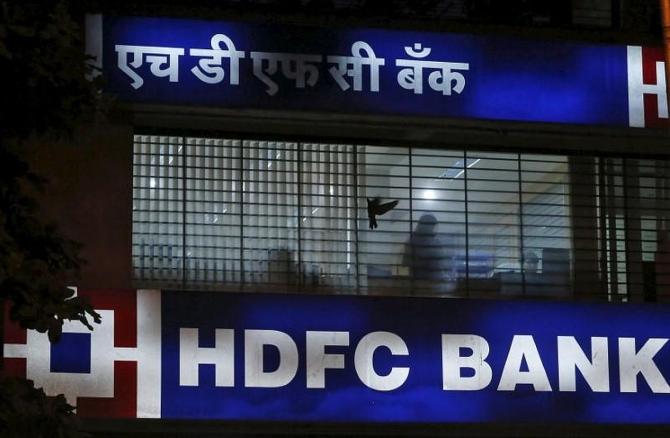Weakness in HDFC Bank's net interest margin (NIM) might have bottomed out in the July-September quarter (Q2-FY24), analysts said on Tuesday, as most of the merger-related one-time adjustments have been done.

The bank, they believe, should be able to grow from here on, allowing the stock to reverse its underperformance.
"The weak NIM print was not unexpected given the merger and regulatory impact caused by the incremental cash reserve ratio (ICRR; 5-10 bps for the quarter).
"The regulation on ICRR, however, has now been withdrawn, which should result in it reversing in Q3-FY24," said analysts at Kotak Institutional Equities.
In the recently concluded quarter, the lender reported NIM of 3.6 per cent on interest earning assets (IEA), and 3.4 per cent on total earnings assets.
The management, however, expects margins to normalise gradually.
Analysts believe the best approach to forecast NIM trajectory would be to compare the loan yields and cost of funds differential with ICICI/Axis Bank and build the NIM convergence cycle based on growth trajectory for the bank and re-pricing of the erstwhile HDFC Ltd borrowings.
However, as these variables are challenging to forecast, the estimates are unlikely to be accurate.
Nonetheless, analysts at Prabhudas Lilladher expect NIM to improve from 3.66 per cent in Q2-FY24 to 3.77 per cent in Q4-FY24.
"Overall FY24 earnings performance would be muted, given the sharp fall in NIM in Q2.
"However, as per our calculations roughly 43 per cent of erstwhile HDFC Ltd liabilities (high-cost) are expected to be replaced by FY26, which should translate to NIM improvement from 3.57 per cent to 3.72 per cent over FY24-26," they said in a result review report.
Meanwhile, the more-than-expected contraction in HDFC Bank’s NIM led to slight hit on core-operating profit at Rs 22,700 crore for the quarter, while cost-income ratio stood at 40.4 per cent (down 240 bps QoQ).
On the contrary, loan book saw a healthy growth of 4.9 per cent QoQ, while deposits grew 5.3 per cent QoQ.
Asset quality witnessed marginal deterioration with some of HDFC Ltd's wholesale loans in the restructured/stage-2 category being classified as Gross Non-Performing Loans.
Net profit grew 33.7 per cent QoQ/50.6 per cent YoY to Rs 15,976 crore, and the net interest income (NII) increased by 30.3 per cent to Rs 27,385 crore.
"We expect sequential improvement in HDFC Bank's core earnings momentum as NIMs recover gradually.
"We believe that current valuations adequately capture the merger related pangs and should alleviate concerns regarding compression of return on assets (RoAs) over the medium-term. As HDFC Bank's liabilities momentum sustains, we expect the stock to revert its recent underperformance," said analysts at JM Financial.
At the bourses, shares of HDFC Bank climbed 1.8 per cent intraday before closing 0.77 per cent higher. By comparison, the benchmark S&P BSE Sensex gained 0.39 per cent.
The stock, however, has underperformed the market by delivering returns of -8.2 per cent/-7.5 per cent/6.5 per cent over the past 3 months/6 months/12 months as against the Sensex’s return of -0.2 per cent/10.87 per cent/13.72 per cent, respectively, during the period.
Going ahead, analysts believe sustained RoA/RoE growth, stable management, and valuation comfort make it a good bet over the medium-to-long term.
The long-awaited listing of HDB Financial Services should be another catalyst for the stock, they said.
"HDFC Bank has made a good beginning after the merger, and given a huge pace of capacity building, we believe that there are levers in place to sustain this momentum in business growth.
"Margins are likely to recover gradually, which, along with improved operating leverage should improve return ratios.
"We estimate HDFC Bank to deliver a CAGR of 18 per cent/20 per cent in loans/deposits and a 21 per cent CAGR in earnings over FY24-26, translating into RoA/RoE of 2 per cent/17.4 per cent by FY26,” said Motilal Oswal Financial Services.












 © 2025
© 2025